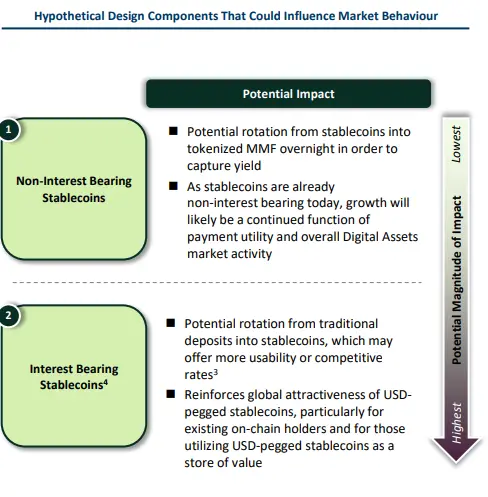Report interpretation: How do you view stablecoins, a think tank of the US Treasury?

Reprinted from chaincatcher
05/22/2025·22DOriginal source:TBAC
Author: Shenchao TechFlow
Stablecoins are undoubtedly a hot topic in the crypto market in the past week.
Previously, the GENIUS stablecoin bill passed the Senate procedure to vote , and then the Hong Kong Legislative Council passed the "Stablecoin Bill" for the third reading. Stablecoin has now become an important variable in the global financial system.
In the United States, the future development of stablecoins is not only related to the prosperity of the digital asset market, but also may have a profound impact on the demand for treasury bonds, bank deposit liquidity and US dollar hegemony.
A month before the passage of the GENIUS bill, the Treasury Borrowing Advisory Committee (TBAC), the U.S. Treasury Department's "think tank" was used to explore in-depth the potential impact of stablecoin expansion on U.S. fiscal and financial stability.
As an important part of the Treasury’s formulation of a debt financing plan, TBAC’s recommendations not only directly affect the issuance strategy of U.S. Treasury bonds, but may also indirectly shape the regulatory path of stablecoins.
So, how does TBAC view the growth of stablecoins? Will this think tank’s view affect the Ministry of Finance’s debt management decisions?
We will use TBAC's latest report as a starting point to interpret how stablecoins evolve from "on-chain cash" to an important variable that will influence U.S. fiscal policy.
TBAC, financial think tank
First, let’s introduce TBAC.
TBAC is an advisory committee that provides economic observation and debt management advice to the Ministry of Finance, and its members are composed of senior representatives from buyer and seller financial institutions, including banks, brokerage dealers, asset managers, hedge funds and insurance companies. It is also an important part of the US Treasury Department's formulation of a debt financing plan.
TBAC Conference
The TBAC meeting mainly provides financing advice to the U.S. Treasury Department and is an important part of the U.S. Treasury's formulation of a debt financing plan. From the perspective of the financing plan process, the US Treasury Department’s quarterly financing process includes three links:
-
Treasury debt managers solicit advice from first-level dealers;
-
After meeting with the main dealers, the Treasury debt manager solicits suggestions from TBAC; for the questions and discussion materials raised by the Ministry of Finance, the TBAC will issue a formal report to the Minister of Finance;
-
Treasury debt managers make decisions on changes in debt management policies based on research analysis and recommendations received from the private sector.
Report summary: **Impact on US banks, Treasury bond markets, and money
supply**

-
Bank deposits: The impact of stablecoins on bank deposits depends on whether they have the profit function and the operating payment characteristics compared to other financial products. Against the backdrop of increased competition, banks may need to raise interest rates to maintain funds or seek alternative sources of financing.
-
Treasury bond market: The overall increase in demand for treasury bonds, and the reserve requirements in stablecoin legislation will provide additional and growing sources of demand for treasury bonds; the overall shift of the holding period of treasury bonds is forward, and the legislation requires stablecoin issuers to hold treasury bonds with a maturity of less than 93 days, resulting in the concentration of holdings of treasury bonds in the short term.
-
Money Supply: Demand for stablecoins may have a net neutral impact on U.S. money supply. However, the attractiveness of a stablecoin pegged to the dollar could shift current non-dollar liquidity holdings toward the dollar .
-
Impact of existing market structure: Current legislative proposals fail to provide unqualified issuers with access to their main account. Stablecoin issuers are unable to access the Fed, which may exacerbate the risk of stablecoins during periods of stress or volatility.
The current diversification of digital currencies : **a panoramic
view** from private to central bank

This picture provides us with a panoramic view of digital currency, showing its diverse implementation paths and its practical applications in various fields.
- Classification of digital currency
-
Private sector issuance (commercial bank balance sheet)
-
Tokenised Deposits : Blockchainization representing the deposit responsibility of commercial banks.
-
Tokenised Money Market Funds : Tokenization of money market funds based on blockchain.
-
-
Private sector issuance ( central bank balance sheet)
- Stablecoin : A blockchain cash manifestation in 1:1 reserve assets, which can be interest-bearing or non-interest-bearing.
-
Private or public sector issuance
-
Cryptocurrency : Virtual currency based on decentralized networks.
-
Issued by the central bank
-
Trigger Solutions : Connection between blockchain and the central bank's real-time full settlement system (RTGS).
-
CBDC ( Central Bank Digital Currency ) : A form of blockchain cash directly issued and regulated by the central bank.
-
-
- Current market trends
-
Tokenized deposits
- JP Morgan and Citi have launched blockchain-based payment and repurchase activity solutions.
-
Tokenized money market funds
-
BlackRock 's BUIDL has attracted more than $240 million in investment.
-
Franklin Templeton launches BENJI tokens that support Stellar, Polygon and Ethereum blockchains.
-
-
Stable Coin
- The market is dominated by major publishers such as Tether and Circle , with a total market value of approximately US$234 billion.
-
Cryptocurrency
- The total market value is close to $3 trillion, and mainstream currencies include Bitcoin ($1.7 trillion) and Ethereum ($191 billion).
-
Trigger solution
- The mechanism launched by the German Central Bank has promoted the settlement of blockchain assets and traditional payment systems.
-
CBDC
- Of the 134 countries and monetary unions tracked, 25% have been launched, 33% are in the pilot phase, and 48% are still under development.
Status of stablecoin market: a list of market value and key events
The stablecoin market has experienced significant fluctuations and development in recent years. As of April 14, 2025, the total market value of the entire market has reached US$234 billion, of which USDT (Tether) dominates with US$145 billion, while USDC (Circle) follows closely with US$60.2 billion, with the total market value of other stablecoins being US$28.7 billion.

Looking back on the past four years, two major events in the stablecoin market have become a watershed in the development of the industry.
In May 2022, the collapse of the algorithmic stablecoin UST triggered a crisis of trust in the entire DeFi field. The deaning of UST not only caused the market to question the feasibility of algorithmic stablecoins, but also affected the market confidence of other stablecoins.
Immediately afterwards, the regional banking crisis in March 2023 once again put the market into turmoil. At that time, USDC’s issuer Circle had about $3.3 billion in reserves frozen at Silicon Valley Bank (SVB), causing USDC to temporarily dean. This incident has caused the market to reevaluate the transparency and security of stablecoins' reserves, while USDT further consolidates its market share during this period.
Despite the repeated crises, the stablecoin market has gradually recovered in 2024 and is in sync with the development of the broader digital asset market. In 2024, the United States launched the first batch of spot crypto ETFs, providing institutional investors with tools to access BTC and ETH.
At present, the growth of the stablecoin market is mainly due to three aspects: the increase in institutional investment interest, the gradual improvement of the global regulatory framework, and the continuous expansion of on-chain application scenarios.

Digital currency market funds **and stablecoins: Comparison of
two on-chain assets**
With the rapid growth of Tokenized Money Market Funds (MMFs), a narrative of alternative stablecoins has gradually formed. Although there are similarities in usage scenarios between the two, a significant difference is that stablecoins cannot become income-based tools under the current GENIUS Act, while MMFs can bring returns to investors through underlying assets.

Market potential: from 230 billion to 2 trillion US dollars
The report believes that the market value of stablecoins is expected to reach about $2 trillion in 2028. This growth trajectory not only relies on the natural expansion of market demand, but is also driven by a variety of key drivers, which can be summarized into three categories: adoption, economics and regulation.

-
Adoption : participation of financial institutions, on-chain migration of wholesale market transactions, and merchant support for stablecoin payments are gradually promoting it to become a mainstream payment and trading tool.
-
Economic : The value storage function of stablecoins is being redefined, especially the rise of interest-based stablecoins, providing holders with the possibility of profit generation.
-
Regulation : If stablecoins can be included in the capital and liquidity management framework and obtained a license to serve banks on the public chain, they will further enhance their legality and credibility.
(Note: The stablecoin bill had not been passed when the report was issued, and it had entered the voting process phase at this time)
It is expected that by 2028, the stablecoin market size will grow from the current US$234 billion to US$2 trillion. This increase requires a significant increase in trading volume and assumes that the circulation speed of stablecoins remains unchanged.
Domestic dollar stablecoins dominate the market
-
USD stablecoins account for 83% of the total fiat-pegged stablecoins, which is much higher than other currencies (EUR accounts for 8%, others accounts for 9%.
-
Among the overall stablecoin market value, USD stablecoins account for more than 99% , with a market value of US$233 billion , of which approximately US$120 billion is backed by US Treasury bonds. The market value of non-USD stablecoins is only US$606 million .
-
The market size of USD stablecoins is 386 times that of non-USD stablecoins, indicating its absolute dominance in the global stablecoin market.

Potential impact of stablecoin growth on bank deposits
The growth of stablecoins may have a significant impact on bank deposits, especially whether their design pays interest will become a key factor.
As of the fourth quarter of 2024, the total deposit size in the United States reached US$17.8 trillion , of which non-transaction deposits (including savings accounts and time deposits) accounted for the main part, at US$8.3 trillion and US$2.9 trillion , respectively. Trading deposits include current deposits ($5.7 trillion) and other non-current deposits ($0.9 trillion).

Of these deposits, transaction-based deposits are considered the most "vulnerable", that is, they are more susceptible to stablecoins. The reason is that such deposits usually do not pay interest, are mainly used for daily activities, and are easy to transfer. Uninsured deposits are often transferred by holders to tools with higher returns or lower risks, such as money market funds (MMFs).
If the stablecoin does not pay interest, its growth will mainly rely on payment functions and the overall activity of the digital asset market, so the impact on bank deposits is limited. However, if the stablecoins start paying interest, especially providing higher yields or ease of use, traditional deposits may be transferred to such stablecoins on a large scale. In this case, USD-pegged interest-based stablecoins will not only attract on-chain users, but will also become an important tool for value storage, further strengthening their global appeal.
In summary, the interest attributes of stablecoin design will directly affect its potential impact on bank deposits:
The impact of non-interest stablecoins is relatively small, while interest-based stablecoins may significantly change the deposit pattern.

Potential impact of stablecoin growth on U.S. Treasury bonds
According to public reserve data, major stablecoin issuers currently hold more than US$120 billion in short-term Treasury bonds (T-Bills), of which Tether (USDT) accounts for the highest proportion, with about 65.7% of the reserves being allocated in T-Bills. This trend shows that stablecoin issuers have become important players in the short-term Treasury bond market.

It is expected that in the future, the demand for T-Bills by stablecoin issuers for T-Bills will be closely related to the expansion of overall market tools.
This demand could push up an additional $900 billion in short-term Treasury demand in the coming years.
There is a relationship between the growth of stablecoins and the increase and decrease of bank deposits. Large amounts of funds may flow from bank deposits to stablecoin-backed assets, especially during market volatility or trust crises such as stablecoin deans, and this transfer may be further amplified.
The requirements of the GENIUS Act on short-term Treasury bonds may further promote the allocation of T-Bills by stablecoin issuers.
In terms of market size, the T-Bills held by stablecoin issuers in 2024 was approximately US$120 billion , and by 2028, this figure may grow to US$1 trillion , an increase of 8.3 times . In contrast, the current market size of tokenized government securities is only US$2.9 billion , showing huge growth potential.

In summary, the demand for T-Bills by stablecoin issuers is reshaping the ecosystem of the short-term Treasury bond market, but this growth may also intensify competition between bank deposits and market liquidity.
Potential impact of stablecoin growth on U.S. money supply growth
The impact of stablecoins growth on the US money supply (M1, M2 and M3) is mainly reflected in the potential transfer of capital flows rather than direct changes in total volume.
- Current money supply structure :
-
M1 includes currency, demand deposits and other chequeable deposits in circulation, totaling approximately US$6.6 trillion .
-
M2 includes savings deposits, small time deposits and retail money market funds (MMFs).
-
M3 includes short-term repurchase agreements, institutional MMFs and large long-term deposits.
- The role of stablecoin :
-
Stablecoins are seen as a new means of store of value, especially under the framework of the GENIUS Act.
-
Stablecoins may attract some of the funds to flow out of M1 and M2, turning to stablecoin holders, especially non-USD holders.

Potential impact
- Transfer of funds :
The growth of stablecoins may not directly change the total amount of US money supply, but will cause funds to be transferred from M1 and M2. Such transfers may affect the liquidity of banks and the attractiveness of traditional deposits.
- International impact :
Stablecoins, as a way to acquire the dollar, may increase demand for the dollar by non-dollar holders, thereby increasing inflows to the U.S. money supply. This trend may promote the use and acceptance of stablecoins worldwide.
Although the growth of stablecoins will not immediately change the total money supply in the United States, its potential as a store of value and a way to obtain money may have a profound impact on capital flows and international dollar demand. This phenomenon needs attention in policy formulation and financial regulation to ensure the stability of the financial system.
Possible directions for future stablecoin regulation
The current stablecoin regulatory framework proposed by the United States is similar to the reform requirements of the MMF after 2010, with the focus:
-
Reserve requirements : Ensure high liquidity and security of stablecoin reserves.
-
Market Access : Explore whether stablecoin issuers can obtain access to the Federal Reserve (FED) support, deposit insurance or 24/7 repurchase market.
These measures are designed to reduce the risk of stablecoin deanning and enhance market stability.

Summarize
- Market size potential
The stablecoin market is expected to grow to approximately US$2 trillion by 2030 under continuous market and regulatory breakthroughs.
- Domestic anchored by the dollar
The stablecoin market is mainly composed of stablecoins anchored by the US dollar , which has focused the recent focus on the potential U.S. regulatory framework and its legislation on the accelerated impact of stablecoin growth.
- Impact and Opportunities on Traditional Banks
Stablecoins may have an impact on traditional banks by attracting deposits, but at the same time create opportunities for banks and financial institutions to develop innovative services and can benefit from the use of blockchain technology.
- The far-reaching impact of stablecoin design and adoption
The final design and adoption of stablecoins will determine the extent to which they affect the traditional banking system and the potential driving force for U.S. Treasury demand .



 jinse
jinse
